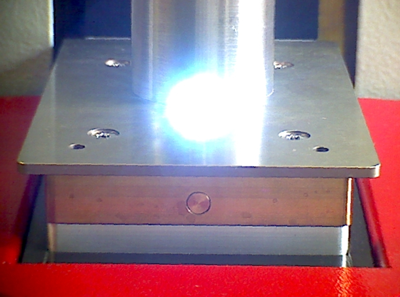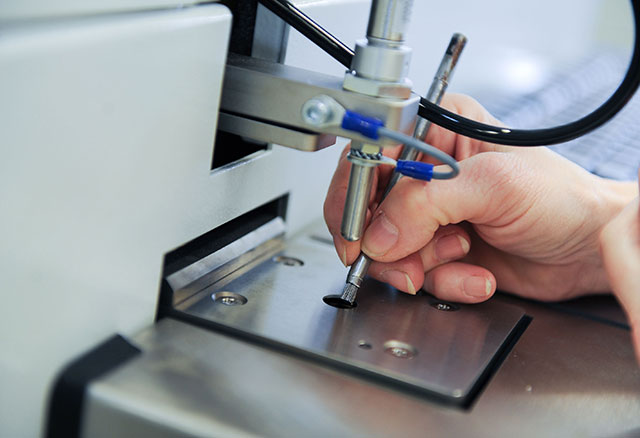 In the spark stand, sparks are generated between a tungsten electrode and the analyte with a repetition rate of 100 to 1000 Hz. During the sparking phase, every spark removes material particles from the sample. These particles must be completely purged from the spark chamber to guarantee operation without having to clean the spark stand. The spark stand has to be fitted with a light channel to direct the emitted light to the optical system. The light channel and spark chamber have to be flushed with argon as traces of ambient air would prevent any meaningful analysis due to poorly formed focal spots and a consequent insufficient degree of repeatability. Furthermore, analysing carbon, nitrogen or oxygen requires a pure argon atmosphere. Should this be necessary, the spark stand can also kept permanently flushed with argon when the spectrometer is in stand-by mode. This prevents air from entering the spectrometer when it is not in operation, but increases running costs.
In the spark stand, sparks are generated between a tungsten electrode and the analyte with a repetition rate of 100 to 1000 Hz. During the sparking phase, every spark removes material particles from the sample. These particles must be completely purged from the spark chamber to guarantee operation without having to clean the spark stand. The spark stand has to be fitted with a light channel to direct the emitted light to the optical system. The light channel and spark chamber have to be flushed with argon as traces of ambient air would prevent any meaningful analysis due to poorly formed focal spots and a consequent insufficient degree of repeatability. Furthermore, analysing carbon, nitrogen or oxygen requires a pure argon atmosphere. Should this be necessary, the spark stand can also kept permanently flushed with argon when the spectrometer is in stand-by mode. This prevents air from entering the spectrometer when it is not in operation, but increases running costs.
The spark stand should be made of non-wearing materials, in particular the spark stand plate and counter-electrode, as this results in longer intervals between necessary adjustments. Buzzwords like “maintenance-free spark stand” are indicators of this.
A few years ago, spark frequencies typically did not exceed 400 Hz. As a result of improvements in excitation and argon flow, frequencies of up to 1000 Hz can be achieved today. However, this requires complete spark chamber deionisation in the intervals between sparking phases. Higher frequencies lead to shorter analysis times.
OBLF Technology
The sparking process must occur under extremely well defined conditions for results to be reproducible. After all, the aim is to ensure that information about the composition of a sample is reproducibly displayed in the emitted light spectrum. The light radiated from the spark stand then turns data carrier and can be analysed by the optical system.
The OBLF spark stand ensures outstanding reproducibility and long-term stability of analysis results thanks to the excellent fluidic design of its inner workings, the use of high-quality materials as well as intelligent constructive engineering. These positive properties remain intact for the whole of the spectrometer’s service life and without any servicing needs! This is also due to the integrated self-cleaning function, which works on the basis of a high-pressure argon pulse and can only be found in OBLF spectrometers – the technology is patent protected! The intervals between cleaning the spark stand can therefore be extended to 104 sparkings.
Our overall concept has naturally also taken everything into consideration to ensure a minimised memory effect, which has resulted in a typical value of <10-6!
Despite the bundled know-how that has gone into this relatively small component, its design affords the user open and easy access, thus also enabling analysis of large and irregular samples. The integrated automatic sample pressing device ensures rapid sample changes.
This unique combination of development parameters was specially selected for automated spectrometer applications and guarantees continuous interference-free automated operation. For applications in automated production lines, the spark stand is fitted with an additional motor-driven cleaning function for the counter-electrode. This closes off the spark stand between analyses and thus takes the strain off the handling system.
When manually operating the system, users benefit from the safe, quick and convenient handling function throughout the device’s entire service life.
OBLF Spark Stand – Technical Specifications:
| Medium: | argon-flushed |
| Wavelength range: | upwards of 100 nm |
| Spark succession frequency: | up to 1 kHz |
| Argon consumption: | program-dependent, upwards of 3 l per analysis no consumption during standby |
| Sample contact pressure: | pneumatic |
| Useful electrode life: | 105 sparkings |
| Memory effect: | typically <10-6 |
| Electrode cleaning | automatic cleaning as option |
read more »

